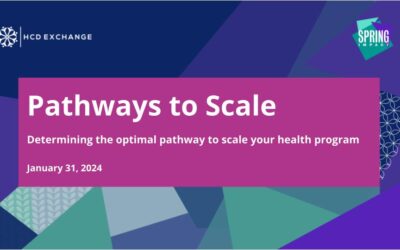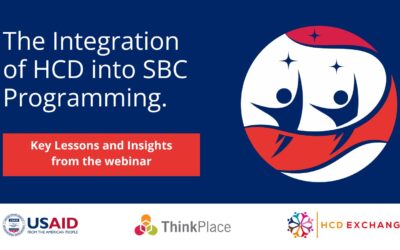On February 2, 2020, the HCDExchange held its first community call of the year to tackle the topic of adolescent insights. Many organizations working with young people on sexual and reproductive health aspire to integrate the voices of young people in informing their programmes. However, this hasn’t been easy for organizations to do in a productive, collaborative and results-oriented way.
On this call, we explored the question: how might human-centred design facilitate the process of gathering and using informative insights from youth?
Panelists from the HCDExchange Community of Practice
The conversation was guided by four members from the HCDExchange Community of Practice, who provided many of the insights summarized below in conversation with the broader community. They were:
- Ilana Cohen, Grassroot Soccer
- Ronard Lubaga, HCDExchange Youth Leadership Hub
- Mary Phillips, Adolescents360
- Sahil Tandon, The David and Lucile Packard Foundation
Key Takeaways
Creativity and agility are key to successfully generating adolescent insights for ASRH using human-centred design
Discussion guide: Ilana Cohen
Generating insights from adolescents in a design research process is generally challenging, but when dealing with sensitive topics like sexual and reproductive health, the roadblocks to getting youth to open up about their experiences are heightened. Participants shared the important role that creative avenues for exploration such as sports and games can play in helping youth achieve the comfort levels and emotional safety necessary to share their experiences on ASRH topics.
Our panelist Ilana Cohen from Grassroot Soccer illustrated how their organization leverages soccer as an entry point to reach adolescents with critical information about their sexual and reproductive health, rights, and available services in their communities.
The community noted that through employing human-centred, participatory techniques in their programme design processes, ASRH implementers will be better equipped to avoid top down approaches while allowing young people to freely express themselves. The space for expression created through HCD enables youth to reveal viewpoints that can help implementers structure responsive ASRH programming grounded in appropriate social context and authentic connections to the young people they serve.
Successfully reaching young people in HCD research requires generating content that resonates and sharing it through relatable channels
Discussion guide: Ronard Lubaga
Participants highlighted that collecting insights from young people and designing interventions with them requires content and engagement channels that are accessible and relatable. The language, tone, and even visual appeal of the communication materials used to help young people understand the subject of the research and the interventions that follow are critical to achieving participation and buy-in.
Ronard Lubaga from HCDExchange’s Youth Leadership Hub highlighted the importance of choosing appropriate delivery channels informed by a thorough understanding of the social context, economic background, and diversity of the target group. He also reiterated the importance of tailoring messages on ASRH when dealing with key populations— particularly recognizing that their experiences fall outside mainstream discourse on SRH and require targeted interventions that factor in the unique marginalization such youth might face.
Insight gathering is not just for the research and discovery phase, but is an evolving process that should continue throughout the project cycle
Discussion guide: Mary Phillips
Often we think of insights as being the preserve of the initial stages of the HCD process, particularly the discovery phase where designers empathize with users and try to understand their challenges to form the basis of the entire intervention design. However, insights can evolve and new ones can emerge as the project advances — unveiling further opportunities for design or necessitating a shift in the approach of an intervention. Designers therefore need to remain alive to the possibility of unexpected insights emerging at any stage of the project and leave room to adapt their strategies in case something consequential is revealed as the project progresses.
Upholding rigorous standards of ethics in design research is especially important when dealing with adolescents
Discussion guide: Sahil Tandon
Ethics in design research serve two purposes: the first is to safeguard the wellbeing and safety of participants, and the second is to assure the quality and integrity of the findings as acceptable new knowledge that can be used to inform policy and practice. Ethics are particularly important when dealing with adolescents who are vulnerable due to age, limited legal agency, economic dependency, and other psychosocial factors.
According to panelist Sahil Tandon, ethics can be viewed as being grounded in three main principles: respect, beneficence, and justice. HCD is particularly well positioned to honour these principles through practices it already prioritizes, such as obtaining consent, ensuring safety and privacy of research participants, elevating participant voices, fostering inclusion, and incorporating community feedback.
However, there still remains a need to be vigilant with respect to ethics even when using HCD for ASRH research. For example, HCD relies heavily on ethnographic documentation through photo, video, and audio. Participants highlighted that these practices have the potential to pose ethical challenges particularly in relation to how such ethnographic data is managed and shared, how that data is used to create impact, and how the ensuing research is communicated.
Resources
Want to learn more about gathering adolescent insights for ASRH using human-centred design ? Here are a few resources shared by community members on the call:
Adolescents360 Open Source resources for HCD+ASRH.
Belmont Report on Research and Ethics.
Many thanks to our community for participating in this call. If you missed the call, you can watch it on our Youtube Channel.



